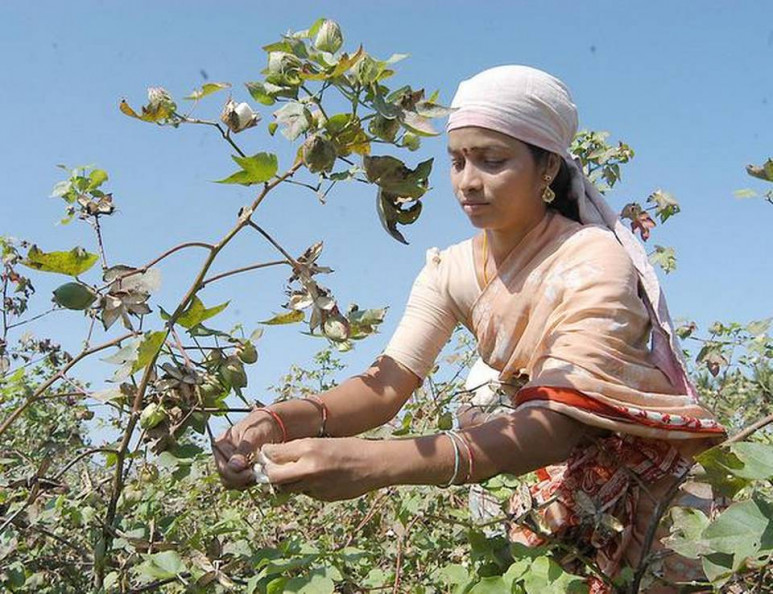|
Since Mar 2019, Indian cotton, S-6, 1-5/32, has welcomed a round of rise, and its price spread with Pakistani cotton, Grade-3, 1-1/16, and Brazilian cotton, M 1-1/8, enlarges obviously. In May, global cotton prices move lower overall, but the decrement of Indian cotton is limited, and prices present firmness. The firm prices may be supported from the supply side, under the influences of lower 2018/19 cotton output and the slower planting progress dragged down by less rainfall.
According to the latest report of USDA, Indian cotton output is projected at 25.50 million bales (480 pounds per bale) in 2018/19 season, down 12% or 3.50 million bales from last season, while demand is supposed to be 24.8 million bales, up 2.7% or 650,000 bales. Therefore, ending stocks are estimated to decrease by 22.8% to 7.125 million bales. The lower stocks give obvious support to domestic cotton prices. Besides, the time for the price rise from Mar is corresponding to its domestic cotton crop growing period.
Currently, it is still the planting period for Indian cotton crops, and the new arrivals will come intensively till Nov, so during the period, the supply will depend on the stocks and imports. By Jun 6, US cotton export sales to Indian have totaled 300kt in 2018/19 season, an increase of 71% year on year, and the outstanding sales reach 150kt. The export sales of 2019/20 US cotton have reached 20kt, up 20% year on year. The increase of imports fulfills the lower domestic cotton output somewhat.
The dominant factor to influence Indian cotton prices is still its domestic cotton output, and the new cotton output is directly affected by the planting areas. According to DAC&FW, by Jun 14, Indian cotton planting areas have reached 15.318 million hectares in 2019/20 season, a decrease of 9.4% year on year. The areas in Gujarat are projected to decline by 16.5%, while Maharashtra, Telangana and Madhya Pradesh have not started the plantings. Only Rajasthan and Haryana sees a yearly growth of 30.7% and 2.4% respectively.
Currently, cotton planting areas in major growing regions are obviously lower than the previous years, mainly affected by the sharp fall of rainfall in India. According to DAC&FW, during the week from Jun 6 to Jun 12, the rainfall in the major cotton crop growing areas is 56.8mm, lower about 57% than the normal level. From Jun 1 to Jun 12, the rainfall is 91.4mm, down about 53% than the normal level. The lower rainfall restricts the sowing progress of cotton crops.
For the water storage in the major cotton growing areas, by Jun 13, there are 22.68 billion cubic meter (BCM) in 46 reservoirs monitored, an increase of 2.65 BCM year on year and 2.09BCM compared to the prior 10-year average. The current storage in Central and Northern regions is higher than the same period of last season, while that in Southern region is lower. Though the storage improves somewhat this year, the planting progress of cotton is more dependent on the influence of water on soil during the planting period. The storage is mainly used for the irrigation during the growing period.
In general, the decline of Indian cotton output in 2018/19 season gives strong support to its domestic cotton prices, and the rise of imports fulfills the lower cotton output somewhat. The decrease of rainfall drags down the cotton planting progress, which is relatively slower in Gujarat, Maharashtra, Telangana and Madhya Pradesh. From the angle of cotton supply side, Indian cotton prices are expected to keep firm in short run. |
||||||||||||||||||||||||||||||||||||||||||||||||||||||||||||||||||||||||||||||||||||||||||||||||||||||||||||||||||||||||||||||||||||||||||||||||||||||||||||||||||||||||||||||||||||||||||||||||||||||||||||||||||||||||||||||||||||||||||||||||||||||||||||||||||||||||||||||||||||||||||||||||||||||||||||||||||||||||||||||||||||||||||||||||||||||||||||||||||||||||||||||||||||||||||||||||||||||||||||||||||||||||||||||||||||||||||||||||||||||||||||||||||||||||||||||||||||||||||||||||||||||||||||||||||||||||||||||||||||||||||||||||||||||||||||||||||||||||||||||||||||||||||||||||||



